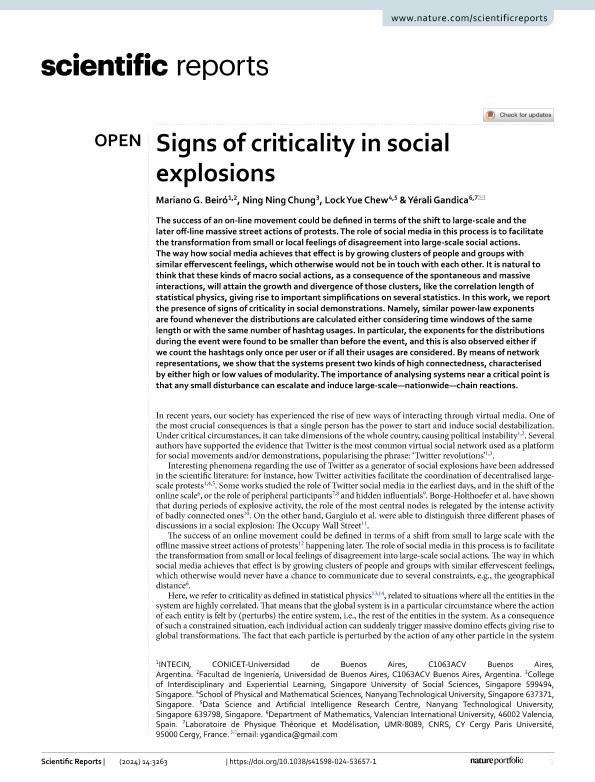Mostrar el registro sencillo del ítem
dc.contributor.author
Beiro, Mariano Gastón

dc.contributor.author
Chung, Ning Ning
dc.contributor.author
Chew, Lock Yue
dc.contributor.author
Gandica, Yérali
dc.date.available
2024-03-18T11:25:01Z
dc.date.issued
2024-02
dc.identifier.citation
Beiro, Mariano Gastón; Chung, Ning Ning; Chew, Lock Yue; Gandica, Yérali; Signs of criticality in social explosions; Springer; Scientific Reports; 14; 1; 2-2024; 1-10
dc.identifier.issn
2045-2322
dc.identifier.uri
http://hdl.handle.net/11336/230751
dc.description.abstract
The success of an on-line movement could be defined in terms of the shift to large-scale and the later off-line massive street actions of protests. The role of social media in this process is to facilitate the transformation from small or local feelings of disagreement into large-scale social actions. The way how social media achieves that effect is by growing clusters of people and groups with similar effervescent feelings, which otherwise would not be in touch with each other. It is natural to think that these kinds of macro social actions, as a consequence of the spontaneous and massive interactions, will attain the growth and divergence of those clusters, like the correlation length of statistical physics, giving rise to important simplifications on several statistics. In this work, we report the presence of signs of criticality in social demonstrations. Namely, similar power-law exponents are found whenever the distributions are calculated either considering time windows of the same length or with the same number of hashtag usages. In particular, the exponents for the distributions during the event were found to be smaller than before the event, and this is also observed either if we count the hashtags only once per user or if all their usages are considered. By means of network representations, we show that the systems present two kinds of high connectedness, characterised by either high or low values of modularity. The importance of analysing systems near a critical point is that any small disturbance can escalate and induce large-scale—nationwide—chain reactions.
dc.format
application/pdf
dc.language.iso
eng
dc.publisher
Springer

dc.rights
info:eu-repo/semantics/openAccess
dc.rights.uri
https://creativecommons.org/licenses/by-nc/2.5/ar/
dc.subject
COMPLEX NETWORKS
dc.subject
CRITICAL PHENOMENA
dc.subject
SOCIAL NETWORKS
dc.subject.classification
Otras Ciencias Físicas

dc.subject.classification
Ciencias Físicas

dc.subject.classification
CIENCIAS NATURALES Y EXACTAS

dc.title
Signs of criticality in social explosions
dc.type
info:eu-repo/semantics/article
dc.type
info:ar-repo/semantics/artículo
dc.type
info:eu-repo/semantics/publishedVersion
dc.date.updated
2024-03-15T11:44:42Z
dc.journal.volume
14
dc.journal.number
1
dc.journal.pagination
1-10
dc.journal.pais
Alemania

dc.journal.ciudad
Berlín
dc.description.fil
Fil: Beiro, Mariano Gastón. Consejo Nacional de Investigaciones Cientificas y Tecnicas. Oficina de Coordinacion Administrativa Houssay. Instituto de Tecnologías y Ciencias de la Ingenieria "Hilario Fernandez Long". Grupo Vinculado al Intecin - Grupo Interdisciplinario en Materiales; Argentina
dc.description.fil
Fil: Chung, Ning Ning. Nanyang Technological University. Singapore Centre for Environmental Life Sciences Engineering; Singapur
dc.description.fil
Fil: Chew, Lock Yue. Nanyang Technological University.; Singapur
dc.description.fil
Fil: Gandica, Yérali. Cergy-paris Universite (cergy-paris Universite); . Centre National de la Recherche Scientifique; Francia
dc.journal.title
Scientific Reports
dc.relation.alternativeid
info:eu-repo/semantics/altIdentifier/url/https://www.nature.com/articles/s41598-024-53657-1
dc.relation.alternativeid
info:eu-repo/semantics/altIdentifier/doi/http://dx.doi.org/10.1038/s41598-024-53657-1
Archivos asociados
